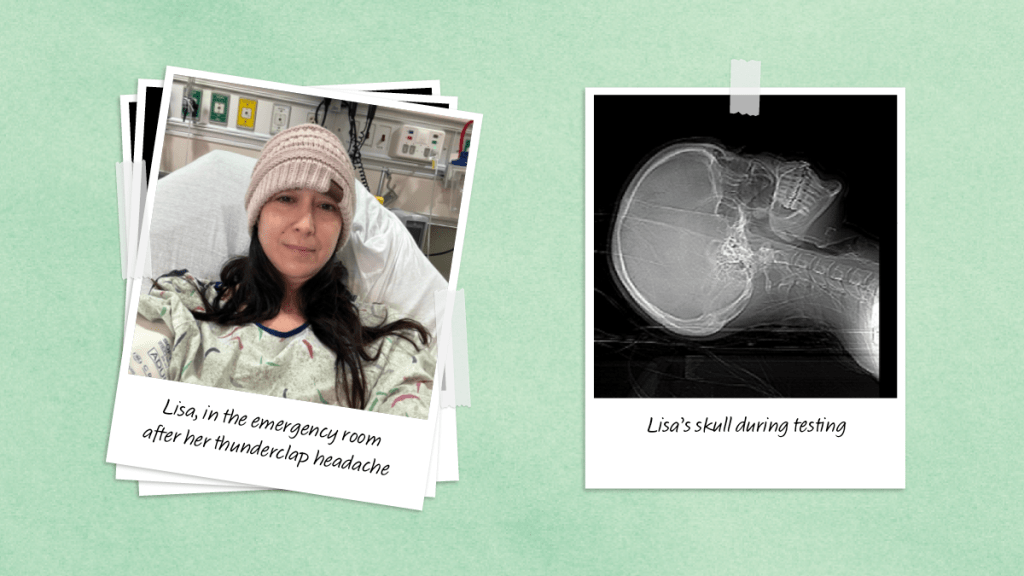I’m not someone who historically suffers from headaches. So I was shocked when I ended up in the ER recently with a potentially life-threatening “thunderclap headache.” As a health writer for the past 25 years, this condition wasn’t even on my radar. But it is now. I’m thankful I survived to tell the tale—not every patient is so lucky. I’m Lisa Maxbauer, a senior editor at FIRST for Women, and here is my story, including everything you need to know about this serious and painful health condition.
The first signs of a thunderclap headache
I was standing in my kitchen, talking to my kids before dinner. And suddenly, I felt something “explode,” for lack of a better word, behind my left eye. It was a pain I’d never experienced before. The kind that forced me to stop what I was doing and clutch my face in my hands. Had my contact lens just torn and lacerated my eye? Had my retina detached? But everything else seemed normal. No visible blood or swelling. Then the searing pain left as quickly as it arrived.
I didn’t have any signs of stroke or other distress. No changes with my vision or balance. No numbness or trouble speaking. So I sort of went on with my day. Lots of things can trigger strange headaches, right? Maybe it was the weather? Perimenopause? Too much computer work straining the muscles in my head? I chalked it up to stress and went to bed early. In hindsight, I don’t recommend that approach. It could have cost me my life!
The pain lingered but I was hesitant to get help
I carefully monitored myself for the next few days. I still felt a dull headache and pressure above my left eye. But everything else seemed normal. I talked to my mom, my husband and my sister who works at a vascular center. We all agreed this was something I should get checked out. But honestly, I wasn’t super eager to spend a day in an urgent care waiting room. Sadly, I knew firsthand that women’s health complaints can be minimized by healthcare providers. I’ve spent my entire career interviewing women who suffered from mysterious, sub-clinical or autoimmune health conditions that doctors tended to miss.
We are often told that feeling sick and tired is normal for women as we age. In fact, around 29 percent of women report that their doctor dismissed their health concerns, according to a 2022 KFF Women’s Health survey. And a 2017 study conducted by the University of Pennsylvania found that only 39 percent of women received the same treatment as men for the same condition. I recalled attending a health conference a few months earlier when Harvard-trained Sara Gottfried, MD, author of The Autoimmune Cure, said, “It’s a health hazard to be female.” So I didn’t rush to get my headache checked out. But again, please don’t be like me.
The doctor’s initial fear about my headache
When I woke up on the fourth day with the same dull pain and pressure, I knew it was time to visit an urgent care clinic. The doctor told me “it’s probably nothing, but some people who present like this have an aneurysm.”
He went on to say anytime someone can describe exactly where they were or what they were doing when pain struck, it indicated a possibly serious situation that warranted further testing. I was sent directly to the hospital emergency room.

Getting diagnosed with a thunderclap headache
I was quickly put in a room in the ER, though from the outside you couldn’t tell anything was wrong. It was a good reminder that many people are dealing with invisible or hidden health conditions. I have naturally low blood pressure, so it took three needle pokes on two different arms and finally a double tourniquet to get my IV in. I was given an IV drug cocktail to help me relax and control the pain, while hydrating my vessels for imaging.
First, I underwent a CT scan of my brain. Luckily, no active brain bleed or clot was found. But the tests didn’t end there. I also needed a more sensitive scan, called a CTA, which uses a contrast dye to take a more detailed 3D picture of my head. This could show damage to smaller blood vessels. Thankfully, that scan didn’t reveal any brain bleeds either.
Next, I learned I needed a lumbar puncture, also called a spinal tap. I got a little teary hearing that. I hated knowing that one of my tests ran a risk of causing a headache after the procedure. But it was the best way to rule out problems like the remnants of a brain bleed from four days ago, or something else like meningitis. That scan came back clear, too.
With the absence of any big warning signs, I was told my pain must have been a “thunderclap headache” and sent home after 8 hours in the hospital. I may never know why it happened. But I’m sharing my story to help others spot the dangers. This is what I learned…
“This is a ‘call 911’ situation. Immediate treatment can make the difference between life and death.” -Dr. Teitelbaum
What is a thunderclap headache?
This type of headache isn’t like a migraine, an illness or a chronic condition—it is most likely a once-in-a-lifetime symptom. The pain can last anywhere from just a few seconds to about 5 minutes. “Thunderclap headaches often are the key warning for life-threatening brain bleeds, such as ruptured brain aneurysms or subarachnoid hemorrhage,” says pain and fatigue expert Jacob Teitelbaum, MD, author of You Can Heal From Long Covid. “This is a ‘call 911’ situation. Immediate treatment can make the difference between life and death.” To underscore the seriousness, he adds, “aneurysms are more likely to rupture in females.”
Look for two key characteristics of thunderclap headaches…
- If this feels like the worst headache of your life
- If the pain came on suddenly in under a minute
Thunderclap headaches fall into two main categories
Thunderclap headaches usually take one of two forms. It can be triggered by a serious health issue like an aneurysm or stroke, or it can mysteriously occur on its own, as it did in my case. Dr. Teitelbaum explains, “If no cause of the thunderclap headache is found, then the doctor may give a diagnosis of ‘primary thunderclap headache.’ This label is not very meaningful except to say that ‘we have checked you over, we do not know what caused the headache, but it is not dangerous.’”
Who’s at risk for a thunderclap headache?
About 1 in 300 people will experience a thunderclap headache in their lifetime. And the chances increase with age. J. David Prologo, MD, an interventional radiologist at Emory University, says, “Smoking, high blood pressure and certain connective tissue disorders increase one’s risk.” He adds, “Women have a higher incidence, as do minorities.” Why you may be hearing about this health phenomenon more lately: “our ability to detect and treat them has improved, which may result in increasing numbers of diagnoses.”
Other things to consider
- Thunderclap headaches can also be caused by blood vessel spasms or Reversible Cerebral Vasoconstriction Syndrome (RCVS), triggered by prescribed medications such as nasal decongestants or antidepressants or illicit drug use. Dr. Teitelbaum says, “these spasms can decrease over time by increasing magnesium intake.”
- Thunderclap headaches can happen during sexual activity. Dr. Teitelbaum says, “When these headaches occur during orgasm, the medication indomethacin before intercourse can be especially helpful.”
- Patients who survive a thunderclap headache may be left with persistent fatigue, brain fog or other symptoms that doctors dismiss, says Dr. Teitelbaum. “Why? Because in 27 percent of these cases, they have hormonal problems that do not show up on the blood test normal range. These include thyroid, adrenal and reproductive hormones,” he says, citing a 2007 JAMA study. He adds, “This figure is the tip of the iceberg. It is actually much higher.” So continue to be your own best health advocate to seek help for your unique health concerns.
Thunderclap headaches making news
I’m not the only person who has survived a thunderclap headache. Bret Michaels of the band Poison experienced a thunderclap headache in 2010 when he felt a burst in the back of his head and experienced a brain hemorrhage, followed by a stroke. It was nearly fatal. He reported “It felt like a pop. They call it a thunderclap…It’s like a migraine times 10.”
Likewise, actress Sharon Stone experienced a thunderclap headache in 2001 when she described feeling a “lightning bolt” sensation to the head and suffered a stroke. Top doctor William Li, MD, even mentioned in his book Eat To Beat Your Diet that “the world’s hottest chili pepper, according to Guinness World Records, is the Carolina Reaper, which… is “so hot that it put one eater in the hospital with a condition called the ‘thunderclap headache.’”
This content is not a substitute for professional medical advice or diagnosis. Always consult your physician before pursuing any treatment plan.




